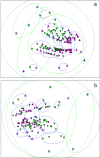Individual personality predicts social network assemblages in a colonial bird
- PMID: 36859497
- PMCID: PMC9977762
- DOI: 10.1038/s41598-023-29315-3
Individual personality predicts social network assemblages in a colonial bird
Abstract
Animal personalities manifest as consistent individual differences in the performance of specific behavioural expressions. Personality research has implications for zoo animal welfare, as it can further our understanding of how captive individuals may differ in their resource use and provide insight into improving individual and group social health. For group living species, personality may enable assortment based on similar behaviour and influence an individual's interactions with conspecifics (e.g. social support). This research aimed to document how personality traits (aggressive, exploratory, submissive) influenced the social network structure of highly social animals in a captive environment. Data were collected from separate flocks of captive Caribbean (Phoenicopterus ruber) and Chilean flamingos (Phoenicopterus chilensis) to identify relationships between birds and examine opportunities for social support. The flocks associated non-randomly, and in both cases, personality was a substantial predictor of network structure. Personality also predicted key elements of Caribbean flamingo social role (degree, betweenness and average association strength) conflict outcome, and propensity to provide social support, however these patterns were not replicated within the Chilean flamingo network. While both species appear to assort by personality, the broader relationship between personality and social role may vary depending on species and context.
© 2023. The Author(s).
Conflict of interest statement
The authors declare no competing interests.
Figures



References
-
- Croft DP, et al. Behavioural trait assortment in a social network: Patterns and implications. Behav. Ecol. Sociobiol. 2009;63:1495–1503. doi: 10.1007/s00265-009-0802-x. - DOI
-
- Morton FB, Weiss A, Buchanan-Smith HM, Lee PC. Capuchin monkeys with similar personalities have higher-quality relationships independent of age, sex, kinship and rank. Anim. Behav. 2015;105:163–171. doi: 10.1016/j.anbehav.2015.04.013. - DOI
MeSH terms
LinkOut - more resources
Full Text Sources
Medical

